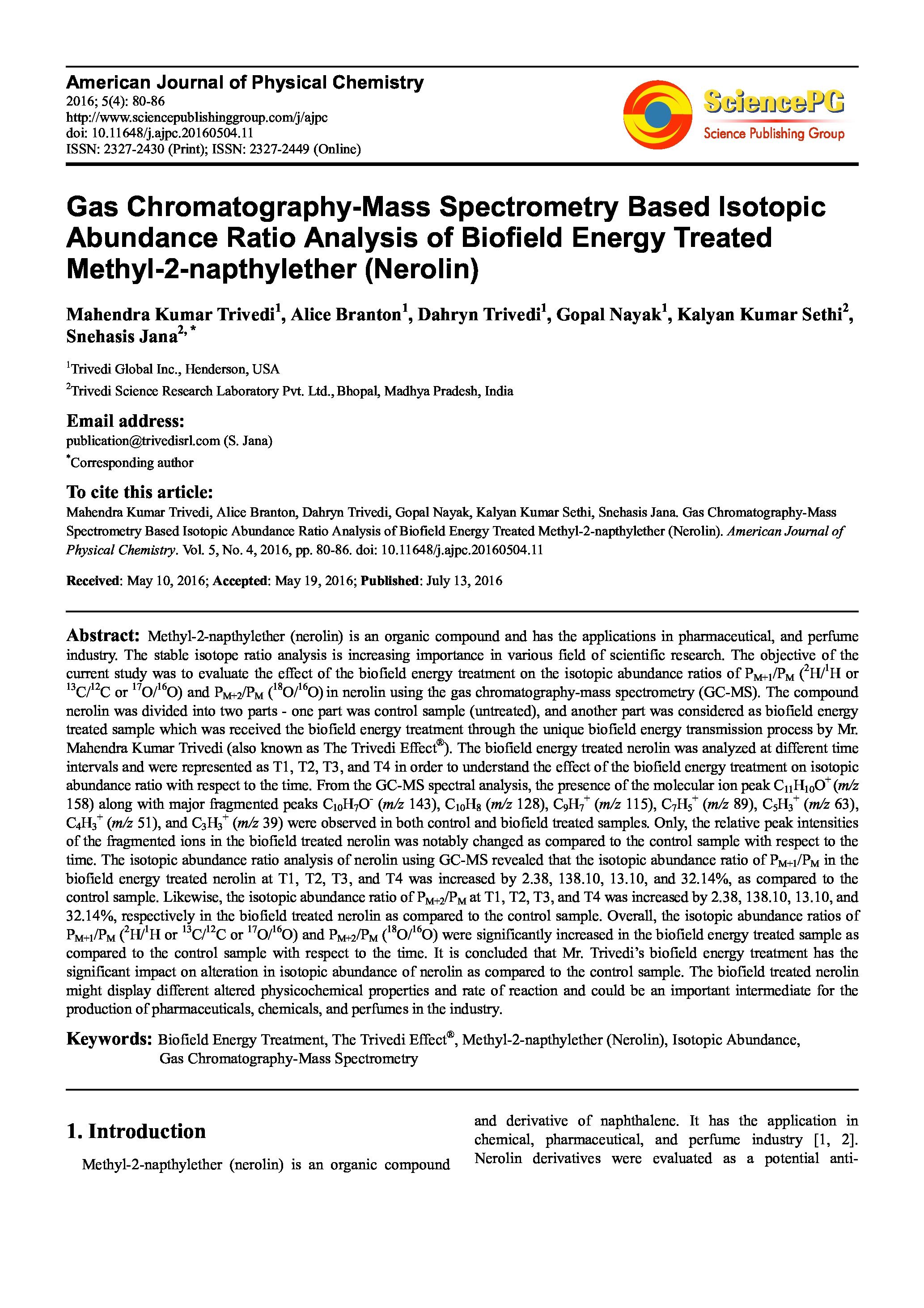Gas Chromatography-Mass Spectrometry Based Isotopic Abundance Ratio Analysis of Biofield Energy Treated Methyl-2-napthylether (Nerolin)
Affiliation
Trivedi Global Inc.; Trivedi Science Research Laboratory Pvt. Ltd.
Main category
Natural Sciences (Biology)
Abstract
Methyl-2-napthylether (nerolin) is an organic compound and has the applications in pharmaceutical, and perfume industry. The stable isotope ratio analysis is increasing importance in various field of scientific research. The objective of the current study was to evaluate the effect of the biofield energy treatment on the isotopic abundance ratios of PM+1/PM (2H/1H or 13C/12C or 17O/16O) and PM+2/PM (18O/16O) in nerolin using the gas chromatography-mass spectrometry (GC-MS). The compound nerolin was divided into two parts - one part was control sample (untreated), and another part was considered as biofield energy treated sample which was received the biofield energy treatment through the unique biofield energy transmission process by Mr. Mahendra Kumar Trivedi (also known as The Trivedi Effect®). The biofield energy treated nerolin was analyzed at different time intervals and were represented as T1, T2, T3, and T4 in order to understand the effect of the biofield energy treatment on isotopic abundance ratio with respect to the time. From the GC-MS spectral analysis, the presence of the molecular ion peak C11H10O+ (m/z 158) along with major fragmented peaks C10H7O- (m/z 143), C10H8 (m/z 128), C9H7+ (m/z 115), C7H5+ (m/z 89), C5H3+ (m/z 63), C4H3+ (m/z 51), and C3H3+ (m/z 39) were observed in both control and biofield treated samples. Only, the relative peak intensities of the fragmented ions in the biofield treated nerolin was notably changed as compared to the control sample with respect to the time. The isotopic abundance ratio analysis of nerolin using GC-MS revealed that the isotopic abundance ratio of PM+1/PM in the biofield energy treated nerolin at T1, T2, T3, and T4 was increased by 2.38, 138.10, 13.10, and 32.14%, as compared to the control sample. Likewise, the isotopic abundance ratio of PM+2/PM at T1, T2, T3, and T4 was increased by 2.38, 138.10, 13.10, and 32.14%, respectively in the biofield treated nerolin as compared to the control sample. Overall, the isotopic abundance ratios of PM+1/PM (2H/1H or 13C/12C or 17O/16O) and PM+2/PM (18O/16O) were significantly increased in the biofield energy treated sample as compared to the control sample with respect to the time. It is concluded that Mr. Trivedi’s biofield energy treatment has the significant impact on alteration in isotopic abundance of nerolin as compared to the control sample. The biofield treated nerolin might display different altered physicochemical properties and rate of reaction and could be an important intermediate for the production of pharmaceuticals, chemicals, and perfumes in the industry.
DOI
10.18147/smn.2017/paper:508
Do you have problems viewing the pdf-file? Download paper
here
If the paper contains inappropriate content, please
report the paper. You will be redirected to the landing page.
